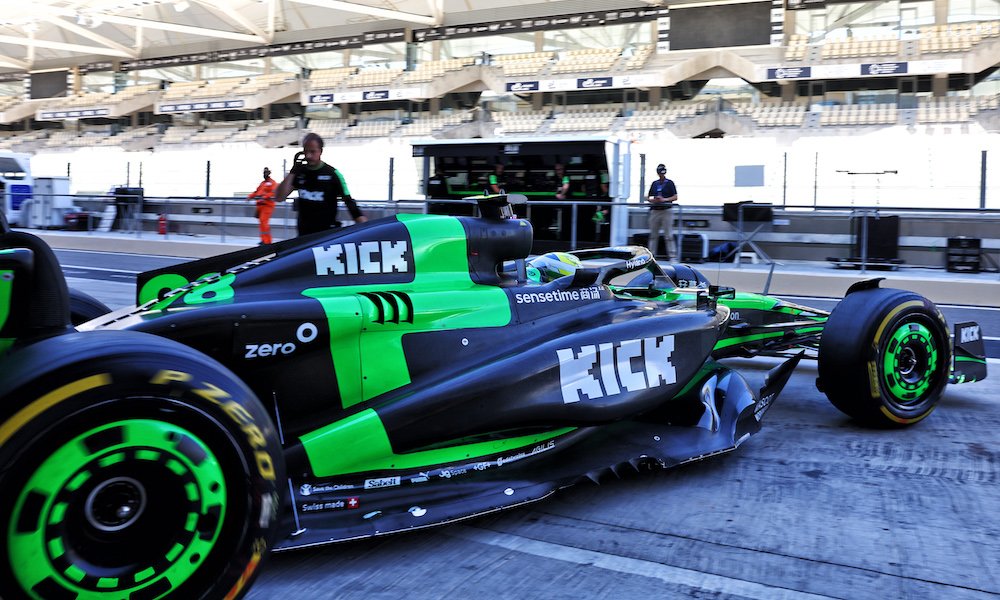
This week’s Method 1 post-season take a look at in Abu Dhabi marked the primary observe outing for the brand new gasoline circulate meter that shall be launched in 2026 when the championship adopts 100 per cent sustainable gasoline.
The machine, developed and constructed by Allengra, was put in within the Mercedes W15, McLaren MCL38, Williams FW46 and Sauber C44 for the session at Yas Marina Circuit. Gasoline circulate meters are used to restrict the quantity of gasoline being despatched to the combustion engine, stopping groups from gaining an influence benefit on sure elements of a lap.
F1 is overhauling its energy unit rules in 2026, with {the electrical} a part of the powertrain being uprated and the interior combustion engine’s contribution being lowered. The championship can also be switching to 100 per cent sustainable content material gasoline, developed by the completely different gasoline suppliers which are partnered with every energy unit producer.
The overhaul can also be heralding a brand new unique provide contact for the FIA-approved F1 gasoline circulate meter, legitimate from 2026 to 2030. Allengra, which at present operates within the FIM World Superbike Championship, received the FIA tender and can substitute Sentronics because the designated provider to all vehicles.
The aim of the Abu Dhabi take a look at was to offer the FIA some preliminary real-world information on how the Allengra gasoline circulate meter performs, having beforehand undergone static dyno rig testing. Each the FIA and Allengra had been happy with its preliminary findings. A key requirement is for the 2026 meter to have +/- 0.5 per cent accuracy in its gasoline circulate measurements, in addition to repeatability and adaptableness for the next-generation gasoline containing completely different sustainably-derived elements.
‘I believe, globally, the take a look at went very nicely,’ mentioned Martin Baerschneider, F1 powertrain engineer on the FIA. ‘We’re actually blissful that the gasoline circulate meters that we ran, ran reliably. The sign was good.
‘We gathered various information as a result of there have been many laps accomplished. We felt that, typically, it labored fairly nicely out of the field.
‘In fact, there are enhancements to be made and studying available for enhancements from the info we gathered. They’ve been examined on the benches on the energy unit producers – partially on the groups as nicely – however that was the primary time in real-life situations within the automobile. Which remains to be very completely different, for those who consider the quantity of vibrations they encounter [and] the g forces in comparison with a static bench take a look at.’
Presently, F1 automobile gasoline tanks are fitted with two gasoline circulate meters made by Sentronics. One is named the ‘workforce FFM’ and the opposite because the ‘FIA FFM’. The previous is a management sensor for the groups to allow them to get as near the utmost gasoline circulate price as potential. The latter incorporates a non-public sign for the FIA which is designed to protect in opposition to tampering.
In 2026, F1 will return to a single gasoline circulate meter that may do the identical job as two.
This meant that for the Abu Dhabi take a look at, the 2026 meter was put in rather than the FIA FFM, whereas the workforce FFM remained in its normal spot. Information from the Allengra meter was transmitted on a non-public FIA channel, so the groups and Sentronics couldn’t see it. Likewise, Allengra couldn’t see something from the workforce FFM.
All ten F1 groups got the possibility to run the 2026 gasoline circulate meter in Abu Dhabi, though lower than half the cohort ended up doing so.
‘It was a chance that we provided to all groups,’ defined Baerschneider. ‘Nonetheless, there’s clearly useful resource wanted to make that work.
‘You could adapt the set up: the shape issue, measurement and mounting is completely different. They’ll doubtlessly should make loom adjustments. They must change the fuel-in / fuel-out connections. To have the ability to adapt that, there’s price and labour concerned.
‘Below the present price range cap scenario, that’s not one thing that every one groups would readily wish to do. We provided an FIA mission to exclude that exercise from the price range cap. However nonetheless, it means there’s workload concerned. Not all of the groups had the time and useful resource to take action, however 4 groups determined to try this for that take a look at.’
The vehicles in Abu Dhabi ran on the identical E10 gasoline (containing 10 per cent renewable ethanol) they used in the course of the 2024 F1 season. Nonetheless, the 2026 gasoline circulate meter will monitor the extra superior 100 per cent sustainable content material gasoline. This may introduce new bio-sourced and synthetically-produced elements.
‘The gasoline circulate meters [at the test] had been calibrated to that particular [2024] gasoline,’ mentioned Baerschneider. ‘The primary samples of the 2026 gasoline are going to Allengra now in order that they get an opportunity to check them.
‘Clearly, the transfer to superior sustainable fuels in 2026 goes to be a problem for everybody. Not only for Allengra, however for lots of different suppliers.
‘[It] is much more aggressive on the {hardware}, so there are challenges for the connectors, but additionally the internals [which are] outdoors of Allengra’s remit. That compatibility testing is now beginning successfully.’
Additional observe exams with the Allengra gasoline circulate meter on the present generations of F1 vehicles are unlikely till the brand new provider’s contract begins in 2026. The Abu Dhabi take a look at was carried out with particular dispensation.
‘I believe the subsequent probability to take action is when the 2026 vehicles are beginning to come collectively,’ prompt Baerschneider. ‘They’ll largely be in full-car dyno testing. We will obtain a bit extra testing on that, on high of the testing that’s taking place at Allengra.’
Trending Merchandise




